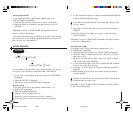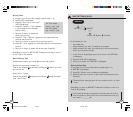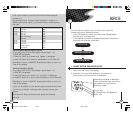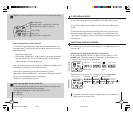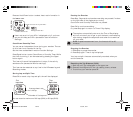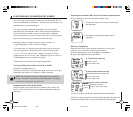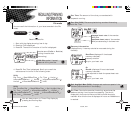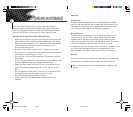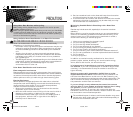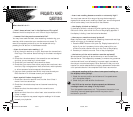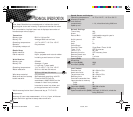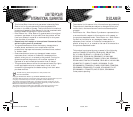
38
38
39
39
Using Heart Rate Monitor while Cycling
While riding a bike, please keep your eyes on the road to prevent
possible accidents and injury.
When using the speed sensor, check that you can turn your handlebar
normally and that cable wires for the brakes or gearing do not catch
on the sensor. Check also that the sensor does not disturb pedaling or
the use of the brakes or gearing.
Using the Polar Heart Rate Monitor in a Water Environment
Your Polar S120 is water resistant to 160 feet/ 50 meters.
Your Polar S150 is water resistant to 100 feet/ 30 meters.
Heart rate measurement in a water environment is technically
demanding for the following reasons:
• Pool water with a high chlorine content and seawater may be very
conductive and the electrodes of Polar transmitter may get short
circuited and EKG signals cannot be detected by the transmitter
unit.
• Jumping into the water or strenuous muscle movement during
competitive swimming may cause water resistance that shifts the
transmitter on the body to a location where it is not possible to
pick up EKG signal.
• The EKG signal strength varies depending on the individual’s tissue
composition and the percentage of people who have problems in
heart rate measuring is considerably higher in a water
environment than in other use.
Polar Heart Rate Monitor and Interferance
Electromagnetic Interference
Disturbances may occur near high voltage power lines, traffic lights,
overhead lines of electric railways, electric bus lines or trams, televisions,
car motors, bike computers, some motor driven exercise equipment,
cellular phones or when you walk through electric security gates.
Exercise Equipment
Several pieces of exercise equipment with electronic or electrical
components such as LED displays, motors and electrical brakes may
cause interfering stray signals. To try to tackle these problems,
relocate the Polar wrist receiver as follows:
1. Remove the transmitter from your chest and use the exercise
equipment as you would normally.
2. Move the wrist receiver around until you find an area in which it
displays no stray reading or flashing of the heart symbol.
Interference is often worst right in front of the display panel of
the equipment, while the left or right side of the display is
relatively free of disturbance.
PRECAUTIONS
g
3. Put the transmitter back on the chest and keep the wrist receiver
in this interference-free area as far as it is possible.
4. If the Polar heart rate monitor still does not work with the exercise
equipment, this piece of equipment may be electrically too noisy
for wireless heart rate measurement.
Minimizing Possible Risks in Exercising with a Heart Rate
Monitor
Exercise may include some risk, especially for those who have been
sedentary.
Before starting a regular exercise program you are recommended to
answer to the following questions for health status checking. If the
answer is yes to any of the questions, we recommend to consult a
doctor before starting an exercise program.
1. Have you not exercised for the past 5 years?
2. Do you have high blood pressure?
3. Do you have high blood cholesterol?
4. Do you have symptoms of any disease?
5. Are you taking any blood pressure or heart medication?
6. Do you have a history of breathing problems?
7. Are you recovering from a serious illness or medical treatment?
8. Do you use a pacemaker or another implanted electronic device?
9. Do you smoke?
10. Are you pregnant?
In addition to exercise intensity, medications for heart, blood
pressure, psyche, asthma, breathing, etc. as well as some energy
drinks, alcohol and nicotine, can affect heart rate.
It is important to be sensitive to your body’s reactions during
the exercise. If you feel unexpected pain or excessive fatigue when
exercising, it is recommended to stop the exercise or continue at a
lighter intensity.
Notice to persons with pacemakers, defibrillator or other
implanted electronic device. Persons who have a pacemaker use
the Polar Heart Rate Monitor at their own risk. Before starting use,
we always recommend an exercise test under doctor’s supervision. The
test is to ensure the safety and reliability of the simultaneous use of
the pacemaker and the heart rate monitor.
If you are allergic to any substance that comes into contact
with the skin or if you suspect an allergic reaction due to using
the product, check the listed materials in the "Technical
Specifications" chapter. To avoid any skin reaction risk with the
transmitter, wear it over a shirt. However, moisten the shirt well under
the electrodes to ensure flawless operation.
The combined impact of moisture and intense abrasion may cause
a black color, which might stain light-colored clothes especially, to
come off the transmitter's surface.
manual S120 150 USA GBR B 18/7/02, 15:5738-39




